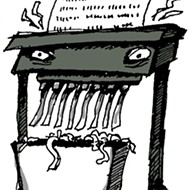[{
"name": "Ad - Medium Rectangle CC01 - 300x250",
"id": "AdMediumRectangleCC01300x250",
"class": "inlineCenter",
"insertPoint": "8",
"component": "2963441",
"requiredCountToDisplay": "12"
},{
"name": "Ad - Medium Rectangle LC01 - 300x250",
"id": "AdMediumRectangleCC01300x250",
"class": "inlineCenter",
"insertPoint": "18",
"component": "2963441",
"requiredCountToDisplay": "22"
},{
"name": "Ad - Medium Rectangle LC09 - 300x250",
"id": "AdMediumRectangleLC09300x250",
"class": "inlineCenter",
"insertPoint": "28",
"component": "3252660",
"requiredCountToDisplay": "32"
}]
Ah youth. The time of your life. The halcyon days. No responsibilities, just free and easy living, right? And yet the National Library of Medicine (NLM) reported in its 2022 National Healthcare Quality and Disparities Report that child and adolescent mental health is in crisis: "Nearly 20 percent of children and young people ages 3 to 17 in the United States have a mental, emotional, developmental, or behavioral disorder, and suicidal behaviors among high school students increased more than 40 percent in the decade before 2019. Mental health challenges were the leading cause of death and disability in this age group."
Did you get that? On average, for every five kids you encounter, one has mental health problems. The pandemic and lockdown certainly exacerbated these issues, but even in our "post-pandemic" world, these problems continue to persist, and here in SLO County, mental health services for kids are virtually nonexistent.
"Take two aspirin and try not to kill yourself in the morning."
One man on the front lines is issuing a call to arms. According to Tom Buckley, executive director of the SLO Chapter of Aspire Counseling Services that offers outpatient services, "More clients have died from self-harm, suicide, and from overdoses than I have seen in my entire career of almost 20 years this year. ... Things are getting more and more dire."
The problem is clear: We don't have adequate services available for the bulk of our underage residents. Sure, kids from very rich families have some options if money is no issue, and the very poor—those who qualify for Medi-Cal—have affordable access to mental health care through the county, but what about most kids—those on their parents' insurance? Surely their insurance must provide something, right? Right?
"The biggest barrier in SLO County is the lack of insurance-based resources," Buckley admitted. "Then there are kids who don't have a lot of money. Their parents are working class people. The county services aren't available to them because they don't qualify for Medi-Cal. But they don't have the cash to go find the other higher end services either. So, they literally have nothing."
Nada. Bupkis. Zilch.
Frank Warren, deputy director of the county's Behavioral Health Department, confirmed that the county's services are only available to those qualified to receive Medi-Cal.
According to data Warren provided, the county receives an average of 35 crisis calls every month from kids under 18 years old. Ninety-seven percent of those kids are transported out of the county to receive care because there's nothing available to them here. There are real consequences to this lack of available services.
According to the aforementioned NLM report, in 2020, "suicide was the 12th leading cause of death in the United States overall; the second leading cause of death for youths ages 10 to 14 years; and the third leading cause of death for people ages 15 to 24 years. Depression is strongly related to both suicidal ideation and it is one of the characteristics that increase the risk of suicide among people with depression."
It's not like we don't know we're in a desperate situation. The 2021-22 SLO County civil grand jury raised the problem in its investigation of the mental health services provided by the county. The question is, what are we going to do about it? We're waiting, SLO County leadership.
You know who else is waiting? Those affected by the 2022-23 winter storms. According to Joshua Roberts of SLO County's Transportation Division, 832 locations were damaged. While 650 have been repaired, the remaining sites await repair, and the county is waiting on FEMA, the Federal Emergency Management Agency—a bureaucracy not known for its speed.
"Every project goes into the FEMA system, and they have to determine the project's eligibility," Roberts explained. "For the most part, all the sites that were damaged in the storm will likely become eligible, and that means once it's determined as eligible, FEMA will participate financially."
Does that mean we're on easy street?
"FEMA's just a partner in getting these [projects] done, and we'll be moving forward regardless, with or without them," Roberts said. "Obviously, we would want FEMA to be included, although FEMA does add a level of complexity, but it also makes the projects affordable in that we become eligible for reimbursements."
That's probably of little comfort to Arroyo Grande resident Nea Wilson, who's had to deal with convenience and safety issues surrounding the closure of Cecchetti Road for nearly a year.
"The closure has created a lot of issues for everyone who lives in the area; traffic on Branch Mill Road and Huasna Bridge has increased exponentially," Wilson said. "Farm equipment, deliveries, and service trucks occasionally are delayed, and there have been minor fender benders due to the excess of traffic."
According to SLO County Public Works Engineer Garret McElveny, residents like Wilson shouldn't hold their breath awaiting a quick fix.
"We're working through the FEMA coordination and environmental permitting currently, and the earliest construction would begin is by summer 2025, but it may be more likely in the summer of 2026," McElveny said. "Construction is looking to last between four to six months."
Meanwhile, Californians and SLO County residents are strapping in for another El Niño. A hard rain's gonna fall. Δ
The Shredder is all wet. Throw it a towel at [email protected].
What's your favorite part of this year's SLO International Film Festival?
Latest in Shredder
Comments (3)
Showing 1-3 of 3
Readers also liked…
-

It ain't pretty
May 4, 2023 -

Carrot kingpins
Aug 17, 2023










